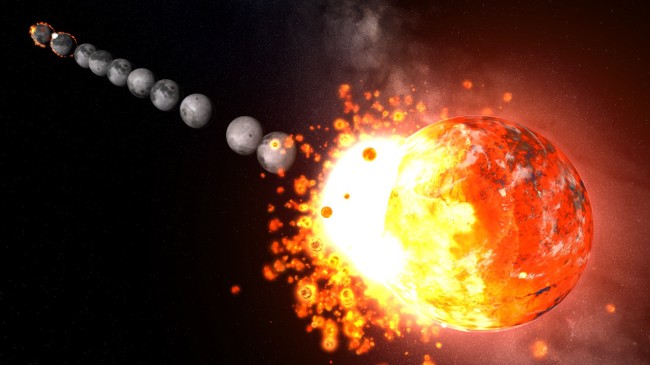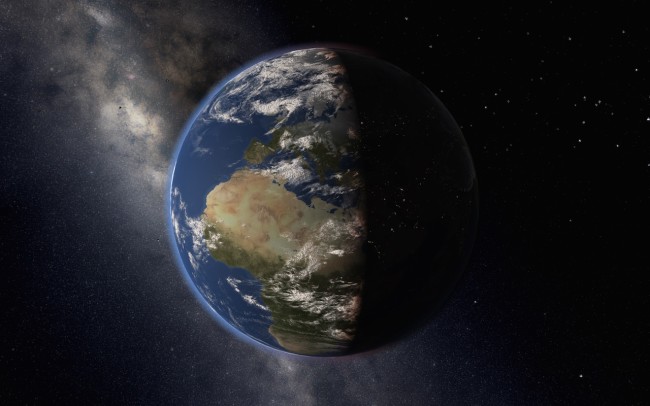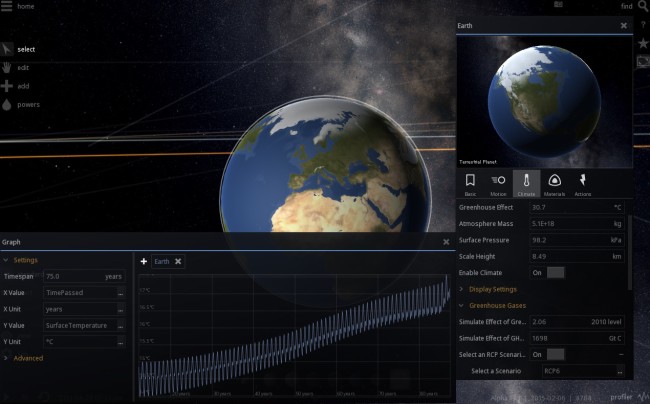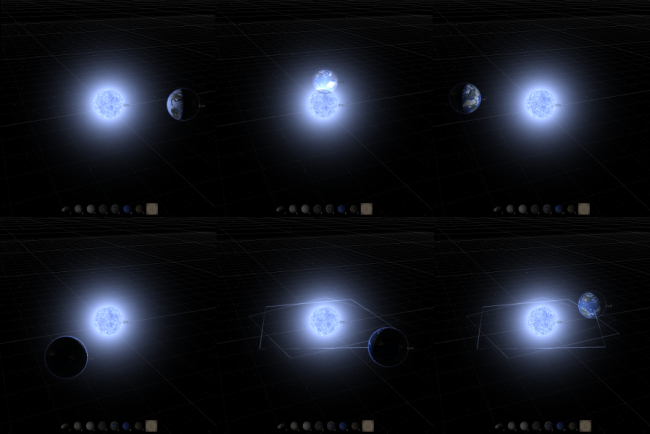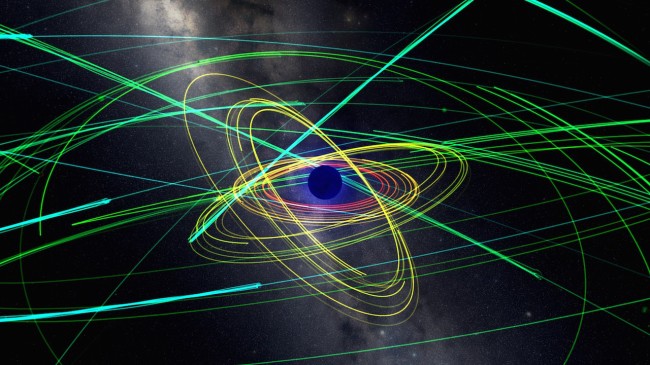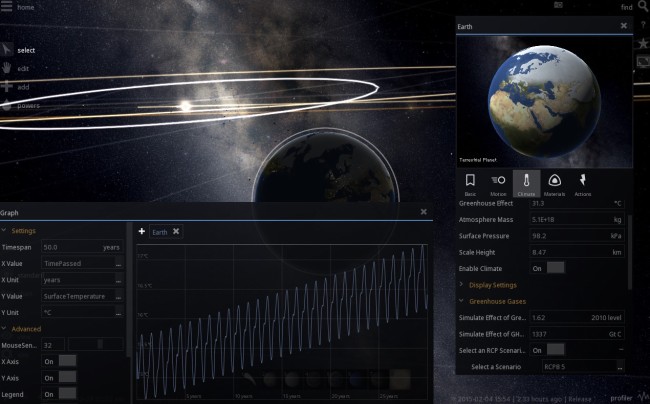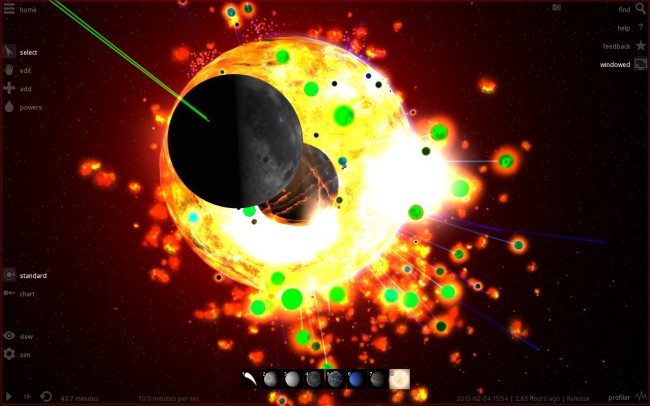Archive for February, 2015
Alpha 14 Now Available
Feb 27th
A long list of bug fixes, first pass on total fragmentation, re-enabled exploder tool, better performance for slower machines, and further improvements to the user interface.
Run Steam to update or buy Universe Sandbox ² now: universesandbox.com.
Our last update introduced a lot of new features, and took a bit longer than we expected. So for Alpha 14 we returned to our monthly release schedule and focused on fixing bugs. Some of these bugs have been around for a few versions, and others were introduced with last update’s big changes.
Total fragmentation is disabled by default as it’s still a work-in-progress, but you can enable it in Simulation settings (gear icon on the left). It can best be seen with the re-enabled exploder tool. Select Powers on the left, then select Exploder, then click on a body to make it instantly explode. This is also a work-in-progress; better transitions are on the way.
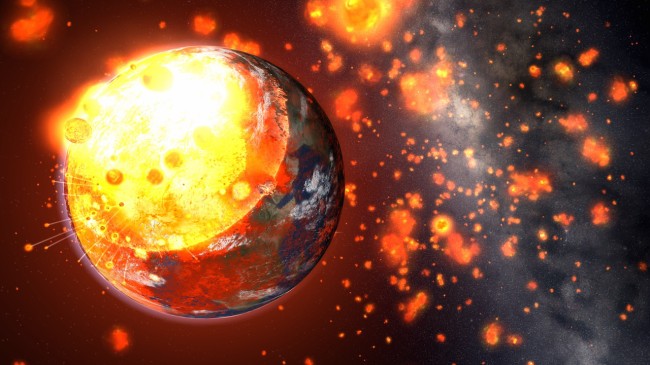
We also made improvements to collision and gravity calculations when running CPU mode. This means better performance for older hardware which can’t run OpenCl mode.
We revamped tooltips for smarter placement and increased visibility. We also made the Launch Body toolbar customizable, so now you can set the hotkeys to launch any body you choose.
For a full list of bug fixes and improvements in Alpha 14, check out the What’s New.
And as always, we’d love to hear your feedback:
Future Earth Climate Scenarios
Feb 20th
One of the most important features in Universe Sandbox ² is the ability to simulate Earth’s climate. It’s a relatively simple simulation, but it helps demonstrate exactly how fragile and ever-changing our climate is.
In Alpha 13, you can select possible future scenarios for Earth’s climate. These scenarios simulate the rise in carbon dioxide levels in Earth’s atmosphere caused by human activity up until the year 2100.
To simulate these, we use the same Representative Concentration Pathways used in the latest report from the Intergovernmental Panel on Climate Change (IPCC). These four pathways are projections for the future of greenhouse gas emissions and resulting concentrations in our atmosphere. You can see each pathway’s projections in the graphs below (left: emissions; right: concentration).

CO₂ emissions and associated concentrations generated from the RCP Database.
There are many factors we can consider when looking at what changes will affect emissions. Policies, land use, global population, our attitudes toward production and consumption — these can all have a huge impact on greenhouse gas emissions. Each RCP makes different assumptions about how and when these factors might change.
To stabilize concentrations, decreases in emissions are required, because even when emissions are lowered, CO₂ hangs around in the atmosphere for a long time.
Not only do the scenarios project different outcomes for concentrations, but, importantly, they each follow a unique trajectory based on a range of possible socio-economic changes. One assumes a peak in greenhouse gases in the next decade, while another assumes that there will never be stabilization. (This is simplified for the sake of this introduction; you can learn more here.)
In Universe Sandbox ², you can enable RCPs by selecting the Climate tab in Earth’s properties and toggling “Select an RCP Scenario.” The default is RCP 8 5. Click the (+) icon to select one of the other 4 scenarios.
Once enabled, the pathway’s concentration level will be tied to the simulation year. The change in net radiative energy balance is also specified by the scenarios, and we put that right into our energy balance as a decrease in outgoing infrared energy. This has the effect of increasing the greenhouse effect and ultimately increases the average temperature of the planet. To see how the different scenarios play out, you can graph Earth’s temperature over the course of several decades. Below is a simulation of RCP6 through 2100.
These pathways are not forecasts. But simulating them in Universe Sandbox ² can help you gain a more intuitive understanding of what is possible for the future of Earth’s climate.
Check out this blog post by Naomi, Universe Sandbox ²’s climate scientist, to learn more about how we simulate climate: Climate in Universe Sandbox ².
You can also check out the climate tutorials right in Universe Sandbox ²: Home -> Main -> Activities.
Physics Changes in Alpha 13
Feb 13th
A riddle: This feature is the biggest feature of Alpha 13, but it doesn’t draw a whole lot of attention to itself. In fact, when it’s working perfectly, you won’t even know it’s there. Without it, though, you’d be shaking your fist at the screen as you watch the whole solar system fall apart. What is it?
The physics rewrite of course! (Maybe the title of this post gave that away.)
While the collision overhaul part of the physics rewrite makes for some impressive visuals, perhaps more important is the addition of a new integration mode and the changes made to the way Universe Sandbox ² handles timestepping.
In short, orbits in Alpha 13 are much more stable, and capable of maintaining this stability even at very high timesteps.
An easy way of demonstrating this difference is to compare the behavior between Alpha 13.1 and Alpha 12 when adding Earth in orbit around Sirius B, a white dwarf that is similar in size to Earth.
Open a new simulation, add Sirius B, then add Earth close by. In Alpha 12, unless you drastically lower the timestep from the default of 1.3 hours per second, Earth quickly gets flung out of orbit.
You can see in the last screenshot above that Earth has shot off the screen. Somewhere, it is speeding off into the depths of space. This is certainly not what you expect when trying to put Earth into a simple orbit. But because of the high timestep and the relatively small orbital period, the simulation cannot calculate Earth’s position accurately enough to keep it in orbit.
This was a common problem in the original Universe Sandbox. Many users expressed their frustration when they’d run the standard solar system simulation, turn up the timestep, and watch as Mercury slingshotted out of its orbit and past Pluto. No, this is not what physics says should happen, but rather a computational limitation. In our FAQ for the original Universe Sandbox, we explained it like this:
- As you turn up the time step you lower the accuracy of the simulation. If the accuracy is too low, bodies will get thrown out of the system.
- The numbers: Mercury takes about 88 days to make a single orbit around the sun. A time step of 22 days would only be calculating a new position for Mercury 4 times in that period. This isn’t enough accuracy to maintain a stable orbit. The Earth is further out and takes 365 days to orbit the sun. This same time step of 22 days results in about 16 position calculations for the Earth which is enough to maintain an orbit.
Fortunately, Universe Sandbox ²’s numerical physics developer, Thomas, has spent a lot of time finding and implementing a solution to this problem.
Now, in Alpha 13.1, you can put Earth into orbit around Sirius B without worrying what the timestep is:
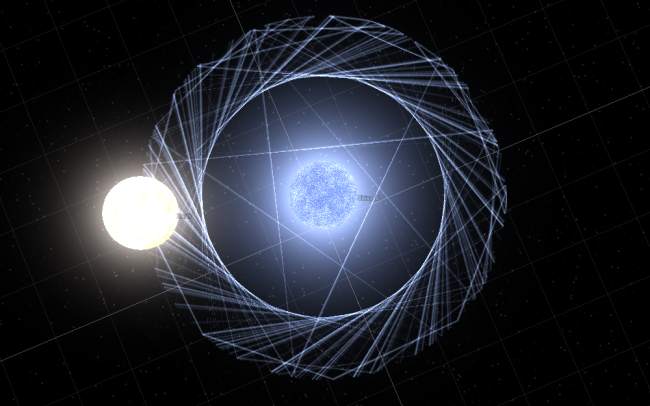
The new Global Adaptive integration mode will always take a safe step in order to maintain the accuracy as determined by the “tolerance” setting. Tolerance is the maximum amount of error that is allowed while taking a step when compared to perfect accuracy (which cannot run in realtime). This number will be much larger for simulations on the galaxy scale than simulations for dice and bowling balls, as the “acceptable” margin of error would be exponentially higher. You wouldn’t want your dice to take a million kilometer leap, but it’s probably okay for them to be off by a centimeter.
Tolerance can be manually adjusted in the settings, or you can let Universe Sandbox ² handle the adjustments. The tolerance is automatically set when loading a simulation to an amount that sufficiently maintains accuracy while also keeping the simulation running smoothly. It is also adjusted whenever a new body is added. We plan to add more automatic adjustments to respond to other simulation changes.
Finally, another large factor in determining stability is the actual numerical integrator that is used, with each having different strengths and weaknesses. For this, we can turn to a video that Thomas has created in order to explain some of the different integrators available in Universe Sandbox ².
While the physics in Universe Sandbox ² is not perfect yet, we’ve made huge strides over the past year. Optimizations in terms of accuracy and performance are an ongoing process, and we look forward to continually improving the simulation.
Alpha 13 Now Available
Feb 6th
Alpha 13 is our biggest update yet.
Overhauled collisions, Mars climate, planetary cutaways, tidal heating and evolution, working orbital elements controls, a better looking UI, and much, much more.
Run Steam to update or buy Universe Sandbox ² now: universesandbox.com.
It’s our biggest update, and it’s also the update we’ve spent the most time on. A lot of this was due to the amount and complexity of the features we’ve been working on. But there were also quite a few unforeseen obstacles and bugs, and add to that some holiday time off… in short, it took us longer than expected. But now there’s plenty to explore, and we don’t think you’ll be disappointed.
In a previous blog post, we showed previews of planetary cutaways, Mars climate simulation, the collision rewrite, and radial velocity and light curves. These are big parts of Alpha 13, but there’s no need to repeat ourselves; let’s look at something new.
Alpha 13 introduces a vastly improved graphing tool. It now plots simulated time, autoscales and autoscrolls, and allows for customizable X and Y axes. You can view specific data by hovering your cursor, and you can easily add and change targets.
Combine that with the new climate feature that lets you simulate future greenhouse gas emission scenarios to get a clearer picture of what could be in store for Earth’s future. To learn more, run the Climate Scenarios activity in Home -> Main -> Activities.
In the screenshot above you can also see the new Milky Way background, the new font, and some new icons for the Properties window.
Also added to the UI is a list of icons at the bottom of the screen that show the bodies bound to the 1-8 number keys. Press 4 a few times to launch some moons at the Earth then turn on the new Body Colors mode for a colorful light show. With Body Colors, the colors of trails, bodies, and fragments are adjusted by mass, acceleration, or velocity.
The new collision system under the hood mean that these collisions will run faster and look better. Calculations have been improved for fragments, craters, momentum, temperature, and every other element of collisions.
The rewrite to physics also introduces a new Global Adaptive integration mode. This mode ensures that, at no matter the timestep, the simulation will retain an accuracy within a user-defined “tolerance” level. This keeps bodies on their proper paths, even when you’re running at thousands of years per second.
Check out our What’s New for a full list of new features, improvements, and fixes. It’s a long list.
We plan to return to a more regular update schedule for Alpha 14. Until then, there’s a lot for you to check out in Alpha 13.
Let us know what you think:

